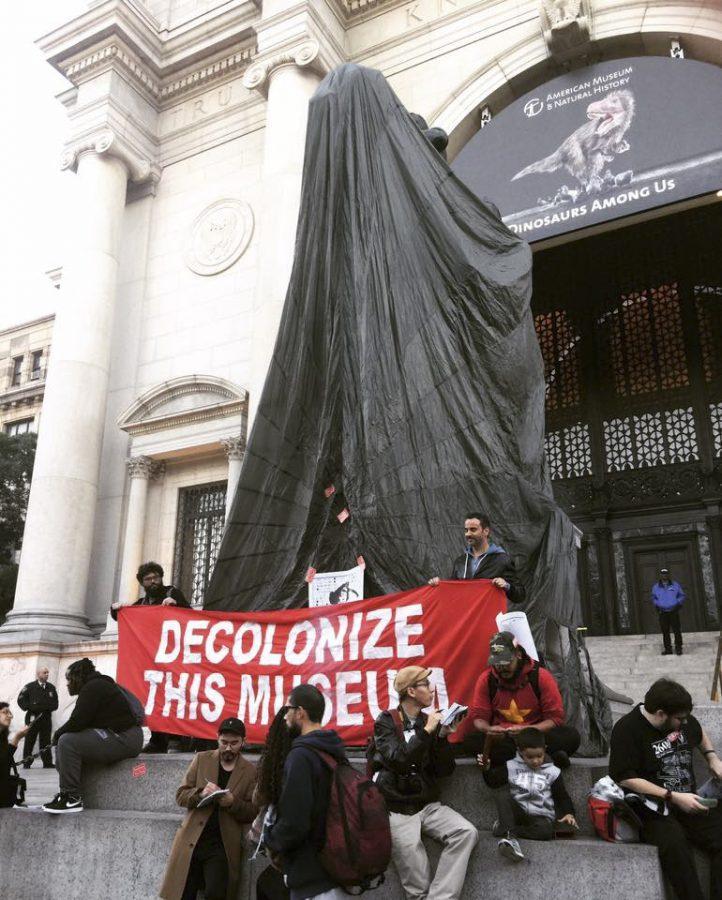Decolonization on the Lower East Side
Activists from NYC Stands with Standing Rock marched through the Museum of Natural History in what they called “Decolonize This Museum” as a performative protest against the South Dakota pipeline.
October 17, 2016
Last Monday, Oct. 11, the Museum of Natural History was crowded in quite a different way than usual. Throughout the museum, visitors wearing stickers that read “Decolonize This Museum” marched and chanted, breaking only for slam poetry and speeches delivered via
Occupy-style human microphone. The focal point of all of this activity was a large tarp draped over the statue of Teddy Roosevelt at the Central Park West entrance. The demonstrations were organized by NYC Stands With Standing Rock, a group that advocates for the Standing Rock Sioux’s rights to their sovereignty, along with a three-month installation (until December 17) at Artist’s Space called “Decolonize This Place.” On Tuesday, representatives for NYC Stands With Standing Rock, along with members of the performance intervention group Liberate Tate and the activist group Global Ultra Luxury Faction, aggregated for a conversation on racism in anthropology called “Decolonize This Museum.”
NYC Stands With Standing Rock is a group that NYU students may be familiar with, as one of its protests took place in September in Washington Square Park. Its action focuses on the planned Dakota Access Pipeline, but also extends beyond this: on Monday, it incorporated prayer and religious rituals from Native American traditions in front of the anthropological exhibits.
Out of the three groups represented, NYC Stands With Standing Rock was the outlier, focusing on more traditional forms of protest. Liberate Tate and GULF have more corresponding goals and use similar methods to achieve said goals — using direct action as art and protest within individual museums. Liberate Tate began in 2010 with the goal of persuading the Tate Museum in London into refusing funds from British Petroleum. GULF is related to the Gulf Labor Coalition, a group which aims to stop worker exploitation by museums in Abu Dhabi, especially the Guggenheim.
Liberate Tate’s many performances include “Human Cost” in 2011, in which a naked man was covered in an oil-like substance in a gallery at the Tate, and “Birthmark” this year, in which volunteers were tattooed with the carbon dioxide atmospheric parts per million of the year they were born, all in museums that accept funds from oil companies. Similarly, GULF has done projections on the exterior of the Guggenheim in New York as well as occupational protests in multiple Guggenheim museums around the world.
While Liberate Tate ultimately succeeded in their goals — the Tate Museum this year ended its relationship with BP — GULF still has a ways to go. The Guggenheim construction in Abu Dhabi is still refusing to work with the unions recommended by the Gulf Labor Coalition. One of GULF’s spokespeople conceded during the talk that “maybe the one-issue approach is problematic.”
The issues that these groups confront are significant, but the most revealing are the photographs of Liberate Tate’s “Human Cost” performance. In the background of the photograph, museumgoers can be seen milling about the gallery as they would on any other day. And, at the end of the day, the activists left the museum, and the tarp was removed from Teddy Roosevelt’s statue.
Since nearly every trace of the protest was removed as the activists left, it was unsurprising that the audience giggled when a GULF representative said that putting stickers on museum labels was just “a warning for what we’re willing to do.” The threat fell flatter than a pancake.
One question, too long to quote here, essentially asked if it was really all worth it. Right now, that seems unclear.
A version of this article appeared in the Monday, Oct. 17 print edition. Email Michael Landes at [email protected].
























































































































































